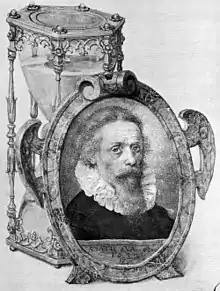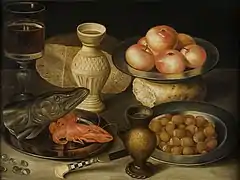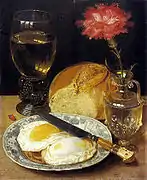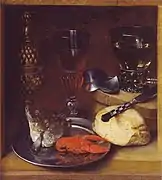
Georg Flegel (1566 – 23 March 1638) was a German painter, best known for his still-life works.
Early life and education

Flegel was born in Olmütz (Olomouc), Moravia. Around 1580 he moved to Vienna, where he worked as an assistant to Lucas van Valckenborch, a painter and draughtsman. Flegel was pupil of Lucas van Valckenborch in Linz from 1582 till 1592.[1]
Flegel later moved to Frankfurt, which at the time was an important art-dealing city. As an assistant, he inserted items such as fruit, flowers, and table utensils into Valckenborch's works.
He is probably the same person Kramm found in Utrecht as ‘juriaen vlegel, Constschilder.’ in the "Protokol" of the notary (or real estate agent) Verduyn, noted as "Acte van 21 Maart, 1616".[2] If so, then he probably moved there because of the new Utrecht Guild of St. Luke and probably knew other still-life painters active there in that period, such as Roelandt Savery (who had made a trip to Tyrol) and Balthasar van der Ast.
Notable works
In a period of about 30 years (c. 1600–1630), he produced 110 watercolor and oil pictures, mostly still-life images which often depicted tables set for meals and covered with food, flowers and the occasional animal. Among his students were his own two sons, Friedrich (1596/1597–1616) and Jacob (probably Leonhard, 1602–1623), as well as the flower artist Jacob Marrel.
Flegel died in 1638 in Frankfurt-am-Main.
- Paintings
 Breakfast Image with herring, Bartmann pitcher and a stag beetle
Breakfast Image with herring, Bartmann pitcher and a stag beetle Still Life with Bread, Haselnuts, Seafood and Apples
Still Life with Bread, Haselnuts, Seafood and Apples Still Life with parrot
Still Life with parrot Still Life with Cherries
Still Life with Cherries Snack with Fried Eggs
Snack with Fried Eggs The big Breakfast
The big Breakfast Still Life with waffles
Still Life with waffles Still Life with Bread and Confectionery
Still Life with Bread and Confectionery Still Life with Dates and Cherries
Still Life with Dates and Cherries Small birds and roasted chestnuts
Small birds and roasted chestnuts Still Life with lobster
Still Life with lobster_Still_life_with_candy.jpg.webp) Still Life with candy
Still Life with candy Dessert Still Life
Dessert Still Life Still Life with herring
Still Life with herring